Since the pony truck was completed work has concentrated of three main areas. Front drag box repairs, rear drag box replacement and axle box refurbishment. What follows is an update on progress so far.
1 – Front Drag box
The decision was taken earlier in the year to replace additional corroded steelwork in the front drag box to ensure that the locomotive has many years of service before any further work in this area is required. New steelwork was welded into place prior to assembling the very complicated parts that make up the front buffer beam. Some of these parts which were already made many years ago required extensive alterations to make them fit. A significant bend in the RH front main frame plate needed to be straightened before the assembly could be persuaded to go together.
Straightening front RHS frame plate
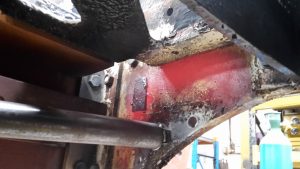
The 1 ¼” steel is heated to dull red and then carefully jacked back straight, it was necessary to repeat this several times in different areas until a straight edge confirmed that the frame was straight again. When the loco arrived from Barry the front RHS corner of the buffer beam was bent, this presumably had happened after 76077 was withdrawn from Springs Branch, either on the journey to Barry Scrap yard or in the Scrap yard when shunting.
Test assembly of drag box steelwork
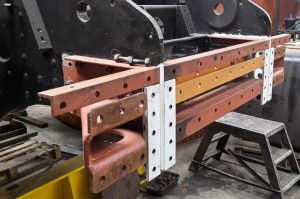
Having test assembled the front drag box all the holes were reamed in preparation for riveting. Next everything needed to be taken off and a step by step system worked out for the order of reassembly. As everything is in such close proximity this was important to ensure we didn’t snooker ourselves and find out that we couldn’t get in to rivet parts together. Also as some parts are totally inaccessible when together areas were painted prior to the riveting so there was a protective paint system in place to help prevent further corrosion.
Riveting up the drag box
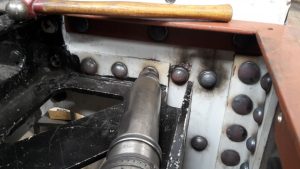
New running board support brackets were fabricated and riveted to the frames as the rivets also go through the pony truck centre casting frame stretcher. The originals were lost at some point in the distant past. The outside corner gusset brackets had to be machined square to ensure the buffer beam was kept straight once the rivets pulled it in tight.
Outside corner gusset and new running board support bracket
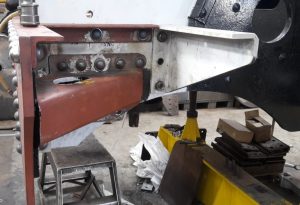
Completed front buffer beam assembly
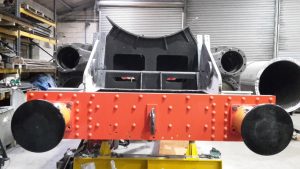
2 – Rear drag box
The rear drag box was always known to need work to replace corroded metal but I decided to obtain a quote for a complete replacement. This quote was favourable and an order was placed though Loughborough Standard Locomotive Group with the fabrication firm Goodman’s Metal Works in Nottingham. It was also decided to replace the rear buffer plank as there was significant corrosion in the centre section and this would have to be removed anyway to withdraw the drag box.
The old drag box removed from frames
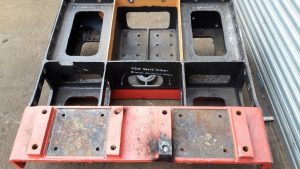
Close up views of corrosion Corrosion on rear buffer plank
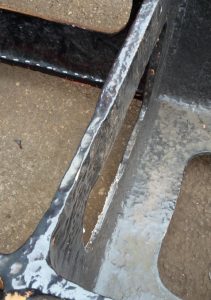
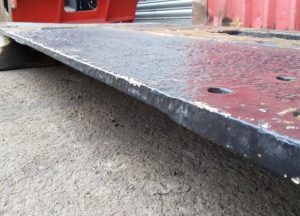
The new drag box was drawn out on CAD and profile cut with a laser, before being welded together. Finally as the dimensions specified are + /- 0.010” of an inch the complete assembly was bolted to a large CNC controlled gantry milling machine to ensure all mating surfaces were flat and true.
New Drag box on CNC milling machine
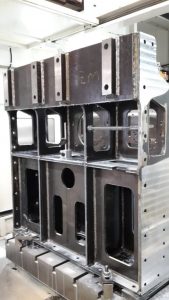
As I write this our volunteers have been busy with the paint brush applying 4 coats of a high performance paint system. As this item is so awkward to get at to paint, we are doing this before fitting as we can turn it upside down and stand it on an edge to gain the best possible access. Once riveted into place then any damaged paintwork will be touched up as required.
Volunteer Rob Southwell applying primer to the new drag box
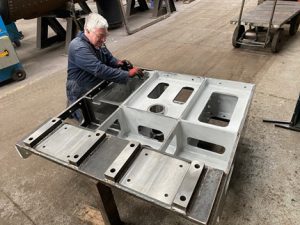
3 – Axle boxes
Apart from a coat of oil to prevent further corrosion, these had no work previously done on them since the loco was dismantled in the early 1990’s. As can be seen from the photos they were in quite a state. The axle boxes are fitted with manganese horn liners which is a hard steel and provides better wear resistance however it is difficult to machine and so grinding was the preferred option. Unfortunately our boxes had heavy corrosion on the liners, particularly on the trailing boxes, so they were milled with special high performance cutters as grinding a few thousands of an inch at a time would have taken forever.
Axle boxes before refurbishment
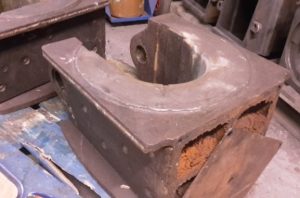
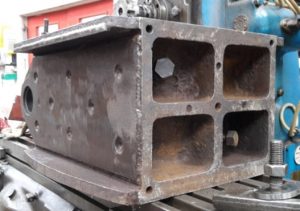
Machined horn faces on axle boxes and Crowns pressed out for re-metaling of bearings
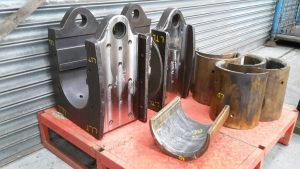
As I write this the crowns are being prepared for new white metal bearing material to be cast in. They will then be pressed back into the axle boxes for machining once the final frame alignment is complete. This alignment can’t be done until the new rear drag box is riveted into position and a detailed survey of the horns taken to ensure everything is straight and true and that the axle centres as set up at the correct distance apart within a tolerance of +/- 0.002”.
You will be pleased to know that even with the additional works discovered and the Covid-19 pandemic disruption, we are still just about on target to re-wheel the loco by the end of 2020.
Andrew Meredith
TSLL Engineering director
